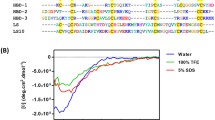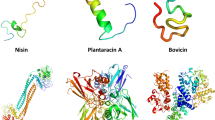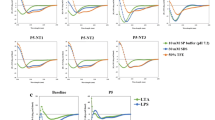Abstract
Anti-microbial peptides (AMPs) are important factors of the innate immune system which perform a comprehensive spectrum of biological activities. The present study aims to examine the expression, purification, and cytotoxic effects of recombinant PI–laterosporulin10 (LS10) a defensing-like peptide. PI is a transmembrane peptide that helps to increase penetration and specificity of peptide targeting. PI–LS10 sequence was optimized and fused to a Xa protease site to achieve higher levels of expression. Then Xa–PI–LS10 was cloned into the pET-32a (+) vector and expressed in Escherichia coli BL21 (DE3). The fusion protein with a molecular weight of about 25.3 kDa was analyzed using the SDS-PAGE. The maximum expression was observed 8 h post-induction. After enzymatic cleavage, the purity of PI–LS10 was > 300 µg/ ml as the final yield. The recombinant PI–LS10 showed anti-cancer characteristics against breast cancer cell lines. MCF7 (non-triple negative) and MDA-MB-231 (triple negative) cells were treated with different concentrations of the PI–LS10 in order to evaluate their cytotoxic activity and efficiency in targeting triple negative cells. Our results suggest that PI–LS10 had a significant cytotoxic effect against breast cancer cells in comparison to the normal cell line. Triple negative breast cancer cell (MDA-MB-231) proliferation inhibited higher in 72 h after treatment compare MCF7 cells. In conclusion, the PI–LS10 peptide was produced successfully and its favorable anti-cancer activity against a breast cancer cell line was confirmed.






Similar content being viewed by others
References
Baindara P, Singh N, Ranjan M, Nallabelli N, Chaudhry V, Pathania GL et al (2016) Laterosporulin10: a novel defensin like class IId bacteriocin from Brevibacillus sp. strain SKDU10 with inhibitory activity against microbial pathogens. Microbiology 162:1286–1299
Baindara P, Gautam A, Raghava G, Korpole S (2017a) Anticancer properties of a defensin like class IId bacteriocin Laterosporulin10. Sci Rep 7:46541
Baindara P, Gautam A, Raghava G, Korpole S (2017b) Anticancer properties of a defensin like class IId bacteriocin Laterosporulin10. Sci Rep 7:1–9
Baneyx F, Mujacic M (2004) Recombinant protein folding and misfolding in Escherichia coli. Nat Biotechnol 22:1399–1408
Bruggeman M, Ijakipour H, Stamboulis A (2019) Defensin-like peptides and their antimicrobial activity in free-form and immobilized on material surfaces. In: Varkey JT (ed) Peptide synthesis. IntechOpen, London
Chen W, Ding H, Feng P, Lin H, Chou K-C (2016) iACP: a sequence-based tool for identifying anticancer peptides. Oncotarget 7:16895
Cicero AF, Fogacci F, Colletti A (2017) Potential role of bioactive peptides in prevention and treatment of chronic diseases: a narrative review. Br J Pharmacol 174:1378–1394
Dinca A, Chien W-M, Chin MT (2016) Intracellular delivery of proteins with cell-penetrating peptides for therapeutic uses in human disease. Int J Mol Sci 17:263
Dong J, Liu W, Jiang A, Zhang K, Chen M (2008) A novel peptide, selected from phage display library of random peptides, can efficiently target into human breast cancer cell. Chin Sci Bull 53:860–867
Dumitrescu R, Cotarla I (2005) Understanding breast cancer risk—where do we stand in 2005? J Cell Mol Med 9:208–221
Erdem Büyükkiraz M, Kesmen Z (2022) Antimicrobial peptides (AMPs): a promising class of antimicrobial compounds. J Appl Microbiol 132:1573–1596
Felício MR, Silva ON, Gonçalves S, Santos NC, Franco OL (2017) Peptides with dual antimicrobial and anticancer activities. Front Chem 5:5
Gao C, Hong M, Geng J, Zhou H, Dong J (2015) Characterization of PI (breast cancer cell special peptide) in MDA-MB-231 breast cancer cells and its potential therapeutic applications. Int J Oncol 47:1371–1378
Hicks RP (2016) Antibacterial and anticancer activity of a series of novel peptides incorporating cyclic tetra-substituted C (α) amino acids. Bioorg Med Chem 24:4056–4065
Hurley J, Reis IM, Rodgers SE, Gomez-Fernandez C, Wright J, Leone JP et al (2013) The use of neoadjuvant platinum-based chemotherapy in locally advanced breast cancer that is triple negative: retrospective analysis of 144 patients. Breast Cancer Res Treat 138:783–794
Kazazic M, Nissen-Meyer J, Fimland G (2002) Mutational analysis of the role of charged residues in target-cell binding, potency and specificity of the pediocin-like bacteriocin sakacin P. Microbiology 148:2019–2027
Kuzmin DV, Emelianova AA, Kalashnikova MB, Panteleev PV, Balandin SV, Serebrovskaya EO et al (2018) Comparative in vitro study on cytotoxicity of recombinant β-hairpin peptides. Chem Biol Drug Des 91:294–303
Mader JS, Hoskin DW (2006) Cationic antimicrobial peptides as novel cytotoxic agents for cancer treatment. Expert Opin Investig Drugs 15:933–946
Marmé F, Schneeweiss A (2015) Targeted therapies in triple-negative breast cancer. Breast Care 10:159–166
Miller KD, Nogueira L, Mariotto AB, Rowland JH, Yabroff KR, Alfano CM et al (2019) Cancer treatment and survivorship statistics, 2019. CA 69:363–385
Mojsoska B, Jenssen H (2015) Peptides and peptidomimetics for antimicrobial drug design. Pharmaceuticals (basel, Switzerland) 8:366–415
Niwa T, Ying B-W, Saito K, Jin W, Takada S, Ueda T et al (2009) Bimodal protein solubility distribution revealed by an aggregation analysis of the entire ensemble of Escherichia coli proteins. Proc Natl Acad Sci USA 106:4201–4206
Pizzolato-Cezar LR, Okuda-Shinagawa NM, Machini MT (2019) Combinatory therapy antimicrobial peptide-antibiotic to minimize the ongoing rise of resistance. Front Microbiol 10:1703
Pucci C, Martinelli C, Ciofani G (2019) Innovative approaches for cancer treatment: current perspectives and new challenges. Ecancermedicalscience 13:961
Puigbo P, Guzman E, Romeu A, Garcia-Vallve S (2007) OPTIMIZER: a web server for optimizing the codon usage of DNA sequences. Nucleic Acids Res 35:W126–W131
Rasmussen N, Ditzel HJ (2009) Scanning the cell surface proteome of cancer cells and identification of metastasis-associated proteins using a subtractive immunization strategy. J Proteome Res 8:5048–5059
Riedl S, Zweytick D, Lohner K (2011) Membrane-active host defense peptides—challenges and perspectives for the development of novel anticancer drugs. Chem Phys Lipid 164:766–781
Russell DW, Sambrook J (2001) Molecular cloning: a laboratory manual, vol 1. Cold Spring Harbor Laboratory Cold Spring Harbor, NY
Sani M-A, Separovic F (2016) How membrane-active peptides get into lipid membranes. Acc Chem Res 49:1130–1138
Singh BP, Aluko RE, Hati S, Solanki D (2022) Bioactive peptides in the management of lifestyle-related diseases: current trends and future perspectives. Crit Rev Food Sci Nutr. 62(17):4593–4606
Smolarczyk R, Cichoń T, Kamysz W, Głowala-Kosińska M, Szydło A, Szultka Ł et al (2010) Anticancer effects of CAMEL peptide. Lab Invest 90:940–952
Utsugi T, Schroit AJ, Connor J, Bucana CD, Fidler IJ (1991) Elevated expression of phosphatidylserine in the outer membrane leaflet of human tumor cells and recognition by activated human blood monocytes. Can Res 51:3062–3066
Vaezi Z, Bortolotti A, Luca V, Perilli G, Mangoni ML, Khosravi-Far R et al (2020) Aggregation determines the selectivity of membrane-active anticancer and antimicrobial peptides: the case of killerFLIP. Biochim Biophys Acta 1862:183107
Walter GJ, Evans HG, Menon B, Gullick NJ, Kirkham BW, Cope AP et al (2013) Interaction with activated monocytes enhances cytokine expression and suppressive activity of human CD4+ CD45RO+ CD25+ CD127low regulatory T cells. Arthritis Rheum 65:627–638
Xu D, Lu W (2020) Defensins: a double-edged sword in host immunity. Front Immunol 11:764
Acknowledgements
This research was financially supported by Shahrekord University (Grant No. 99GRN31M32855). We thank all cooperating with us in conduction of this project, particularly the respectful populates and officials of Shahrekord University.
Author information
Authors and Affiliations
Contributions
BR: performed in vitro experimental prepared initial draft and data collection. SR: coordinated the study, supervised the data collection and proof read manuscript, perform data analysis and article editing. BS and SF: prepared information on complementary literature and performed data analysis. FT: performs article editing and share in prepared initial draft.
Corresponding author
Ethics declarations
Conflict of interest
The authors declare that they have no conflict of interest.
Additional information
Publisher's Note
Springer Nature remains neutral with regard to jurisdictional claims in published maps and institutional affiliations.
Rights and permissions
Springer Nature or its licensor holds exclusive rights to this article under a publishing agreement with the author(s) or other rightsholder(s); author self-archiving of the accepted manuscript version of this article is solely governed by the terms of such publishing agreement and applicable law.
About this article
Cite this article
Rafizadeh, B., Reiisi, S., Saffar, B. et al. Anti-cancer Effect of Recombinant PI-Laterosporulin10 as a Novel Bacteriocin with Selective Cytotoxicity on Triple Negative Breast Cancer Cells. Int J Pept Res Ther 28, 143 (2022). https://doi.org/10.1007/s10989-022-10453-7
Accepted:
Published:
DOI: https://doi.org/10.1007/s10989-022-10453-7




